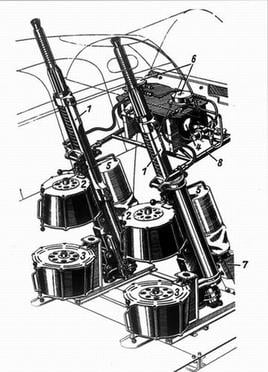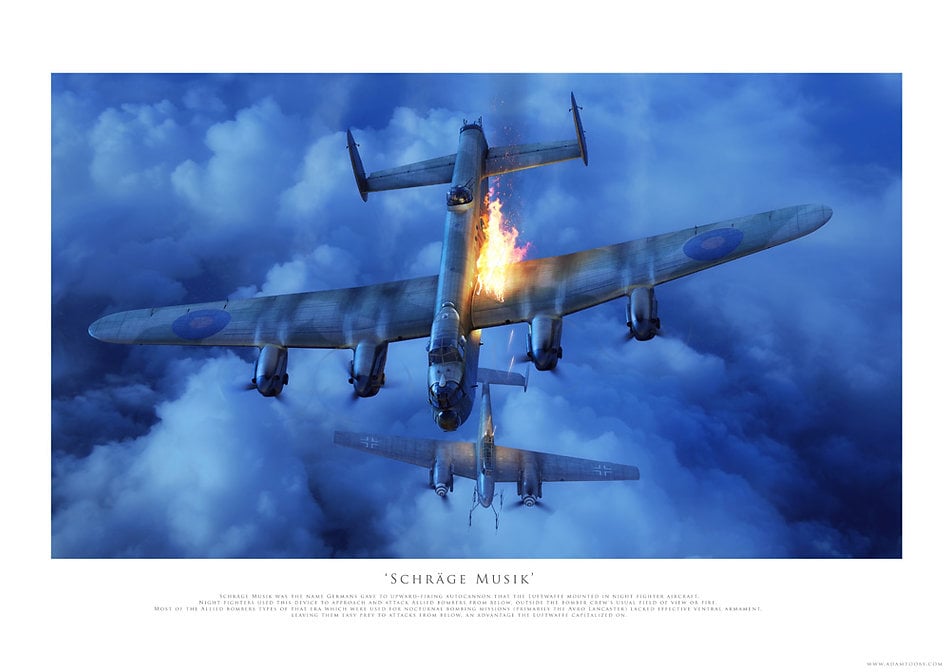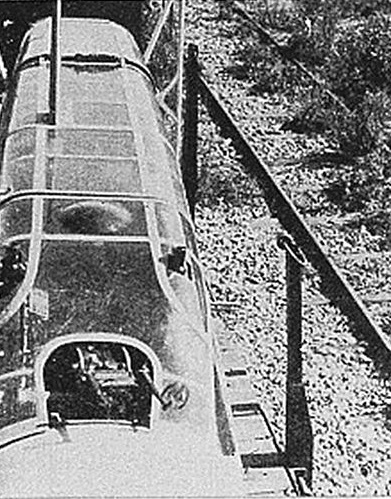The Aviators Thread
SpeedyPhill
·@Jones in LA
How does it feel to get used to that " strange pilot stick " in a Robinson R22 or R44 ?
How does it feel to get used to that " strange pilot stick " in a Robinson R22 or R44 ?
SpeedyPhill
·And now for some real ugly ducklings 😁
Imagine 80 years ago training as an aspirant Naval Aviator or Observer in this Fairey Fulmar at RNAS Yeovilton - Somerset
.
.
This aircraft-carrier-based Recce aircraft, named after a seabird, was only used during World War II developed from the Fairey Battle.
In fact an RAF Fairey Battle was the very first aircraft to shoot down a German aircraft, a Messerschmitt Bf-109 over France during the "Phoney War", a victory for the gunner Sergeant F. Letchford ( 20 SEP 1939 )... so ugly planes but sometimes effective !
.
If You think it couldn't get worse ☕
Here's the lesser-known Blackburn Skua another aircraft-carrier-based single engine two-seater aircraft, in fact the first Royal Navy all-metal monoplane, again named after a seabird ( which divebombs potential predators that come too close to its nest ).
Again sometimes effective, as the Blackburn Skua was the first Fleet Air Arm aircraft to shoot down a German aircraft, a Dornier Do 18 flying boat with crew of 4 over the North Sea, by Naval aviator Lt B S McEwen (+ observer) of Naval Air Squadron 803 ( 26 SEP 1939 )
.
Imagine 80 years ago training as an aspirant Naval Aviator or Observer in this Fairey Fulmar at RNAS Yeovilton - Somerset
.
.
This aircraft-carrier-based Recce aircraft, named after a seabird, was only used during World War II developed from the Fairey Battle.
In fact an RAF Fairey Battle was the very first aircraft to shoot down a German aircraft, a Messerschmitt Bf-109 over France during the "Phoney War", a victory for the gunner Sergeant F. Letchford ( 20 SEP 1939 )... so ugly planes but sometimes effective !
.
If You think it couldn't get worse ☕
Here's the lesser-known Blackburn Skua another aircraft-carrier-based single engine two-seater aircraft, in fact the first Royal Navy all-metal monoplane, again named after a seabird ( which divebombs potential predators that come too close to its nest ).
Again sometimes effective, as the Blackburn Skua was the first Fleet Air Arm aircraft to shoot down a German aircraft, a Dornier Do 18 flying boat with crew of 4 over the North Sea, by Naval aviator Lt B S McEwen (+ observer) of Naval Air Squadron 803 ( 26 SEP 1939 )
.
DoctorEvil
·Fairey do have good form when it comes to making ugly aircraft. This would be a prime contender for one of the ugliest:
The Fairey Gannet was a carrier borne anti-submarine warfare aircraft which first flew in 1949. It became operational with the Royal Navy in 1955. It's quite an interesting design as it is a turboprop with an 8 bladed counter-rotating propeller. The wing folding mechanism is also notable in dividing each wing into 3 segments. There was also an Airborne Early Warning (AEW) variant with a radome under the fuselage, which made the aircraft look even uglier.
The Fairey Gannet was a carrier borne anti-submarine warfare aircraft which first flew in 1949. It became operational with the Royal Navy in 1955. It's quite an interesting design as it is a turboprop with an 8 bladed counter-rotating propeller. The wing folding mechanism is also notable in dividing each wing into 3 segments. There was also an Airborne Early Warning (AEW) variant with a radome under the fuselage, which made the aircraft look even uglier.
JimInOz
··Melbourne AustraliaThat last pic of the AEW Gannet bought back memories of this.
https://omegaforums.net/threads/the-aviators-thread.135513/page-12#post-1885223
https://omegaforums.net/threads/the-aviators-thread.135513/page-12#post-1885223
Turpinr
·And now for some real ugly ducklings 😁
Imagine 80 years ago training as an aspirant Naval Aviator or Observer in this Fairey Fulmar at RNAS Yeovilton - Somerset
.
.
This aircraft-carrier-based Recce aircraft, named after a seabird, was only used during World War II developed from the Fairey Battle.
In fact an RAF Fairey Battle was the very first aircraft to shoot down a German aircraft, a Messerschmitt Bf-109 over France during the "Phoney War", a victory for the gunner Sergeant F. Letchford ( 20 SEP 1939 )... so ugly planes but sometimes effective !
.
If You think it couldn't get worse ☕
Here's the lesser-known Blackburn Skua another aircraft-carrier-based single engine two-seater aircraft, in fact the first Royal Navy all-metal monoplane, again named after a seabird ( which divebombs potential predators that come too close to its nest ).
Again sometimes effective, as the Blackburn Skua was the first Fleet Air Arm aircraft to shoot down a German aircraft, a Dornier Do 18 flying boat with crew of 4 over the North Sea, by Naval aviator Lt B S McEwen (+ observer) of Naval Air Squadron 803 ( 26 SEP 1939 )
.
My general science teacher was air crew in Fairey Battles and hated them.
The Battle has to be a contender for worst allied aeroplane in WW2 which is why the crews who went on suicide missions in them and got VC's thoroughly deserved them.
Turpinr
·27th September 1939
The victim was a Messerschmitt Bf109D-1 from JGr. 152. It was shot down by return fire during an attack on three No. 103 Squadron Battles by four Bf109D-1s from JGr.152 west of Hornbach and crashed near Bockweiler at 1230 hrs. Gefreiter or Obergefreiter (sources differ on his rank) Josef Scherm was killed, the aircraft was a write off. The victor was Leading Aircraftman (LAC) John Ernest Summers in Fiying Officer A.L. Vipan’s K9271. The Bf 109s had attacked just as the Battles had completed their mission to take oblique photographs along the Siegfried Line and turned for home. LAC Summers had held his fire until the Bf 109 attacking his Battle had closed right in before giving it a burst from his Vickers GO gun, whereupon the 109 had fallen into a wood. The observer of his plane, Sergeant J.H. Vickers, was badly wounded and died of his wound on 7 Oct. The pilot F/O Vipan had to make a forced landing onto a field with failing engine. However K9271 wasn’t badly damaged and the other two Battles returned unscathed. LAC Summers was later awarded the Distinguished Flying Medal.
LAC Summers must've had ice in his veins
The victim was a Messerschmitt Bf109D-1 from JGr. 152. It was shot down by return fire during an attack on three No. 103 Squadron Battles by four Bf109D-1s from JGr.152 west of Hornbach and crashed near Bockweiler at 1230 hrs. Gefreiter or Obergefreiter (sources differ on his rank) Josef Scherm was killed, the aircraft was a write off. The victor was Leading Aircraftman (LAC) John Ernest Summers in Fiying Officer A.L. Vipan’s K9271. The Bf 109s had attacked just as the Battles had completed their mission to take oblique photographs along the Siegfried Line and turned for home. LAC Summers had held his fire until the Bf 109 attacking his Battle had closed right in before giving it a burst from his Vickers GO gun, whereupon the 109 had fallen into a wood. The observer of his plane, Sergeant J.H. Vickers, was badly wounded and died of his wound on 7 Oct. The pilot F/O Vipan had to make a forced landing onto a field with failing engine. However K9271 wasn’t badly damaged and the other two Battles returned unscathed. LAC Summers was later awarded the Distinguished Flying Medal.
LAC Summers must've had ice in his veins
Jones in LA
··Not in LA anymore.@Jones in LA
How does it feel to get used to that " strange pilot stick " in a Robinson R22 or R44 ?
Excellent question. At first, I was mentally challenged by the appearance of the 't-bar' cyclic control, and frequently tried to apply inputs that had no effect on the aircraft at all. This is pretty common for first-time Robinson pilots. My brain eventually figured it out and now I don't give it a moment's thought. Having said that, I envy anyone who gets to fly a helicopter with a more conventional cyclic arrangement and would love to try one myself. Unfortunately, most options available to me to fly a conventional cyclic control are attached to turbine-powered aircraft, which would cost somewhere in the $1,500-$2,000/hr range...well out of my budget.
MRC
·And then Fairey produced the beautiful Delta 2. Perhaps because this was a private venture not to an official spec that makes a difference. As was the Rolls-Royce Merlin engine of course.
I flew this aircraft in 1956. Well actually as near a replica as I could make from two dining chairs on their backs with feet touching to make a fuselage/cockpit, cushion for a seat+parachute, a cooking spoon for a stick and some 7-year old imagination. I cried when I saw the FD2 at Cosford because I had no idea one had survived -- the other was modified into the BAC 221 and survives too 👍
I flew this aircraft in 1956. Well actually as near a replica as I could make from two dining chairs on their backs with feet touching to make a fuselage/cockpit, cushion for a seat+parachute, a cooking spoon for a stick and some 7-year old imagination. I cried when I saw the FD2 at Cosford because I had no idea one had survived -- the other was modified into the BAC 221 and survives too 👍
SpeedyPhill
·March 27, 1968... death of Yuri Gagarin
55 years ago, Yuri Gagarin the first man to go into space and orbit the Earth died in a crash onboard a training jet aircraft MiG-15UTI.
Lots of theories about this accident!
https://en.wikipedia.org/wiki/Death_of_Yuri_Gagarin
55 years ago, Yuri Gagarin the first man to go into space and orbit the Earth died in a crash onboard a training jet aircraft MiG-15UTI.
Lots of theories about this accident!
https://en.wikipedia.org/wiki/Death_of_Yuri_Gagarin
SpeedyPhill
·One more for the Brits
JimInOz
··Melbourne AustraliaThe first two aircraft to pass over us were just whistling over, so maybe trainers.
30 seconds later that came out of the trees, made much noise, and then was gone.
I didn't have time for a pic at the time (too busy checking my underdaks), but I got some earlier in the day so I'll try and dig them up.
DoctorEvil
·Excepts taken from the book below:
Omegafanman
·I spoke to a Navigator from the Gulf War (Tornadoes) who now flys a Hurricane on occasion. He said the Tornado was an incredibly stable weapons platform and that the missions were extremely precise, even in a long mission often the time of impact on a target was planned to the second and was integral to other missions. A lot of the mission parameters were loaded via a C90 cassette, on a loitering mission they might pop it out and put in a new fangled cassette iPod converter, so they could play some music instead. There is some history to that. To break the ice on the home leg of the first black Buck mission the Vulcan AEO played chariots of fire when they saw the final refuelling tanker. Until that point it looked like they might run out of fuel with limited chance of survival so far from rescue.
DoctorEvil
·From memory, the RAF Tornadoes took a few losses in the early days of the conflict. It was partly because they were using the JP233 runway denial weapon which required the aircraft to fly straight down an enemy runway, making it's course predictable for AAA.
Omegafanman
·Upward-firing Auto-cannon “Schräge Musik”
So I was at an RAF base yesterday (I will make a thread on that) but this system came up. What was new to me was that Schräge Musik was another word for Jazz Music. Jazz was very popular with the pilots but Hitler banned it as subversive... A lot of the books translate the system as strange off-beat, and shrag can mean slanting. But the guy at the base thought it was mainly a way for the pilots who fought for the country and not for Hitler / Nazis to stick a finger up at the tyrant. Not sure if that is correct and it is a shame the secret weapon was so good at taking down our bombers from 1943.
One of their Nightfighers had 121 victories - aided by this system
Highest Scoring Night Ace - German Major Heinz-Wolfgang Schnaufer - 121 Victories - Air Power Asia
It is also interesting when you look at the list of WW2 aces with Germany and Japan well above the Allies. Japan also used the Schräge Musik but I suspect night fighters were less called for.
List of World War II flying aces - Wikipedia
The fantastic illustration is by Adam Tooby.
.
So I was at an RAF base yesterday (I will make a thread on that) but this system came up. What was new to me was that Schräge Musik was another word for Jazz Music. Jazz was very popular with the pilots but Hitler banned it as subversive... A lot of the books translate the system as strange off-beat, and shrag can mean slanting. But the guy at the base thought it was mainly a way for the pilots who fought for the country and not for Hitler / Nazis to stick a finger up at the tyrant. Not sure if that is correct and it is a shame the secret weapon was so good at taking down our bombers from 1943.
One of their Nightfighers had 121 victories - aided by this system
Highest Scoring Night Ace - German Major Heinz-Wolfgang Schnaufer - 121 Victories - Air Power Asia
It is also interesting when you look at the list of WW2 aces with Germany and Japan well above the Allies. Japan also used the Schräge Musik but I suspect night fighters were less called for.
List of World War II flying aces - Wikipedia
The fantastic illustration is by Adam Tooby.
.
Lépine
·The German Aces were incredible. I know often the US websites put a caveat that US Aces were pulled out of the war zones early hence few scored higher than in the twenties suggesting that if the pilots flew more they would have scored as much as the Germans and the Japanese. It seems it is likely that the American politics had less confidence to leave the US aces in the war zone for fear of loosing them in battle and tarnishing the reputations.
I think the facts remain, the German pilots had the most wins.
I think the facts remain, the German pilots had the most wins.





















